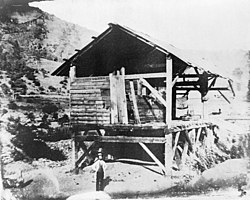Coloma, California
| Coloma, California | |
|---|---|
| census-designated place | |

Coloma, 2008
|
|
| Position in California. | |
| Coordinates: 38°48′09″N 120°53′41″W / 38.80250°N 120.89472°W | |
| Country |
|
| State |
|
| County | El Dorado |
| Area | |
| • Total | 3.355 sq mi (8.690 km2) |
| • Land | 3.355 sq mi (8.690 km2) |
| • Water | 0 sq mi (0 km2) 0% |
| Elevation | 764 ft (233 m) |
| Population (2010) | |
| • Total | 529 |
| • Density | 160/sq mi (61/km2) |
| Time zone | Pacific (PST) (UTC-8) |
| • Summer (DST) | PDT (UTC-7) |
| GNIS feature ID | 1655915; 2582981 |
|
U.S. Geological Survey Geographic Names Information System: Coloma, California; U.S. Geological Survey Geographic Names Information System: Coloma, California |
|
|
Coloma
|
|

Sutter's Mill 1850
|
|
| Nearest city | Placerville, California |
| Area | c. 250 acres (100 ha) |
| Built | 1848 |
| NRHP Reference # | 66000207 |
| Significant dates | |
| Added to NRHP | October 15, 1966 |
| Designated NHLD | July 4, 1961 |
U.S. Geological Survey Geographic Names Information System: Coloma, California; U.S. Geological Survey Geographic Names Information System: Coloma, California
Coloma (formerly, Colluma and Culloma) is a census-designated place in El Dorado County, California, USA. It is approximately 36 miles (58 km) northeast of Sacramento, California. Coloma is most noted for being the site where James W. Marshall found gold in the Sierra Nevada, at Sutter's Mill on January 24, 1848, leading to the California Gold Rush. Coloma's population is 529.
The settlement is a tourist attraction known for its ghost town and the centerpiece of the Marshall Gold Discovery State Historic Park. Coloma was designated a National Historic Landmark District on July 4, 1961.
It lies at an elevation of 764 feet (233 m).
Coloma grew around Sutter's Mill following the finding of gold. A post office was established in 1849 under the name Culloma, changing to Coloma in 1851.
One of Coloma's earliest settlers was Silas Sanderson (1824–1886), who went on to become the 7th Chief Justice of California.
While some people still live in the area, Coloma is considered something of a ghost town because civic buildings such as the jail have been abandoned and left to decay, and other buildings from its boom era (1847-1852) have been converted into museums and other historical displays. The tailrace of Sutter's Mill remains, along with a nearby reconstruction.
In reality the meaningfulness of the township of Coloma has dissipated as residents who live in the wider Coloma Valley area generally share a community spirit.
The town currently has approximately 300 inhabitants. The local economy is predominately agriculture and tourism. Of particular note is the rafting industry as the South Fork American River is one of the most popular white water trips in North America.
...
Wikipedia

